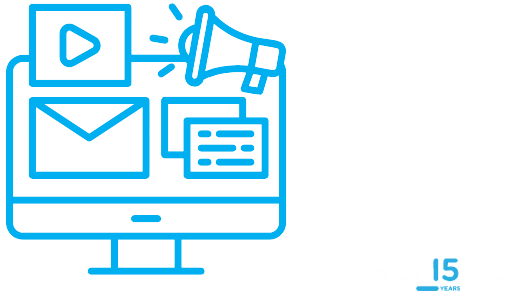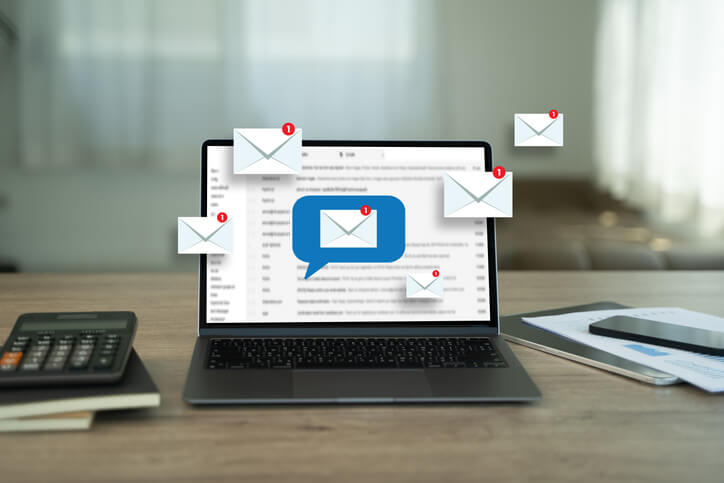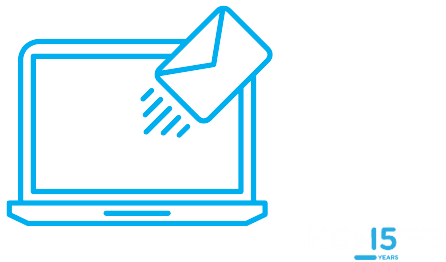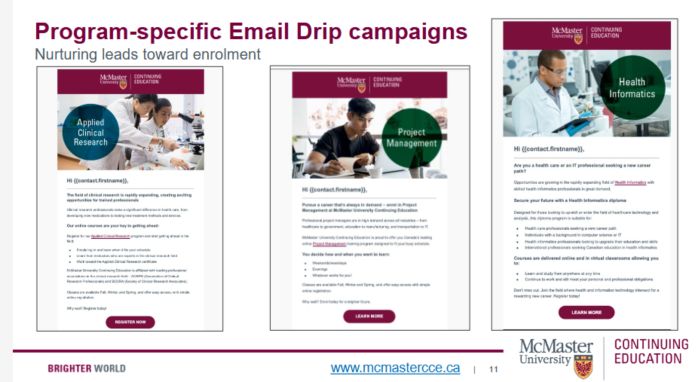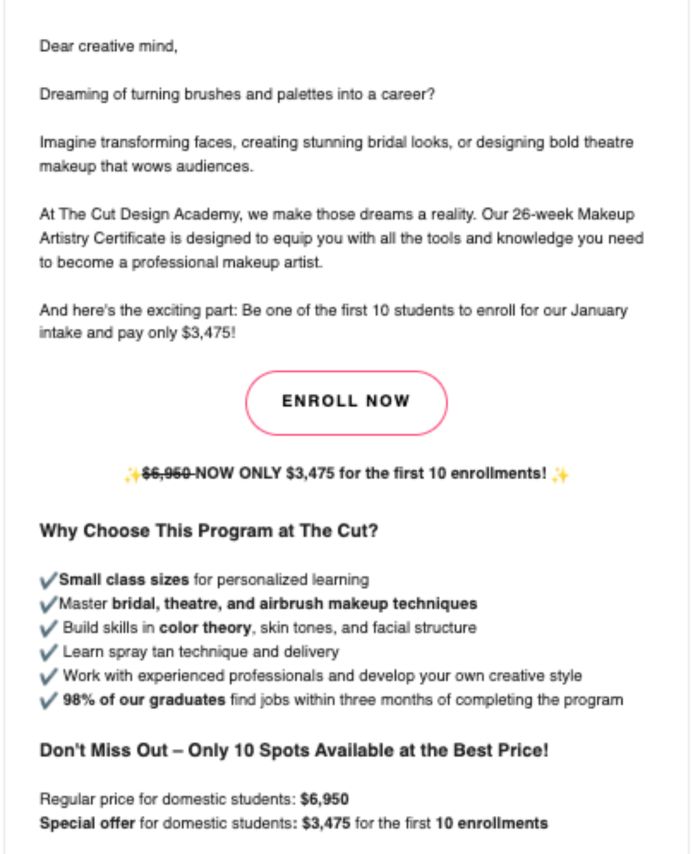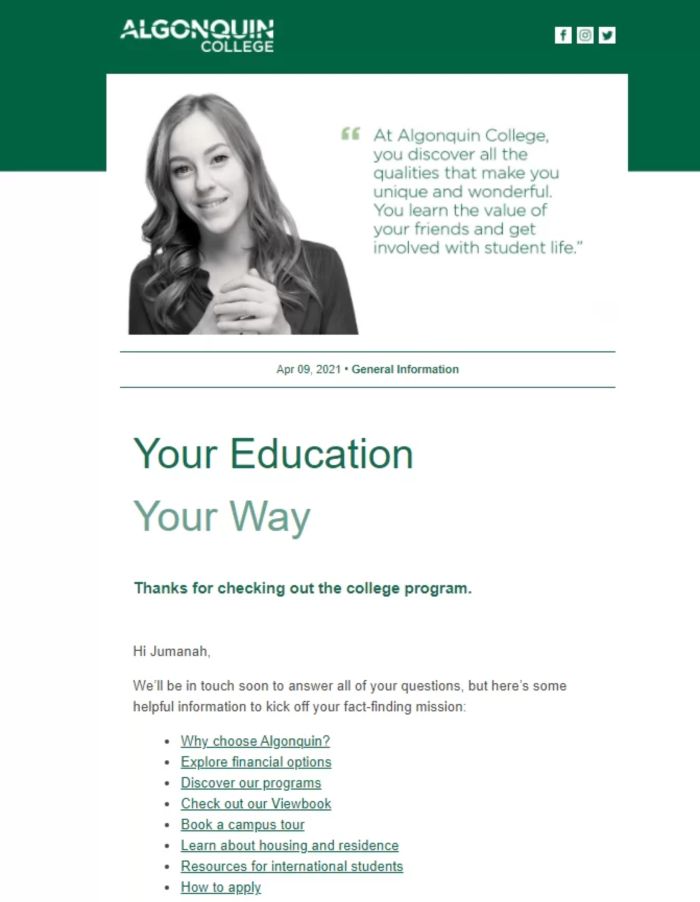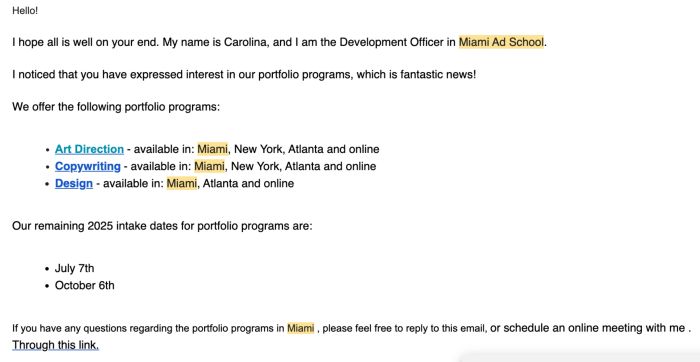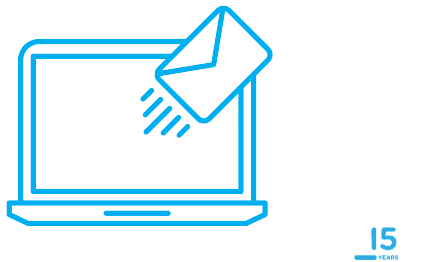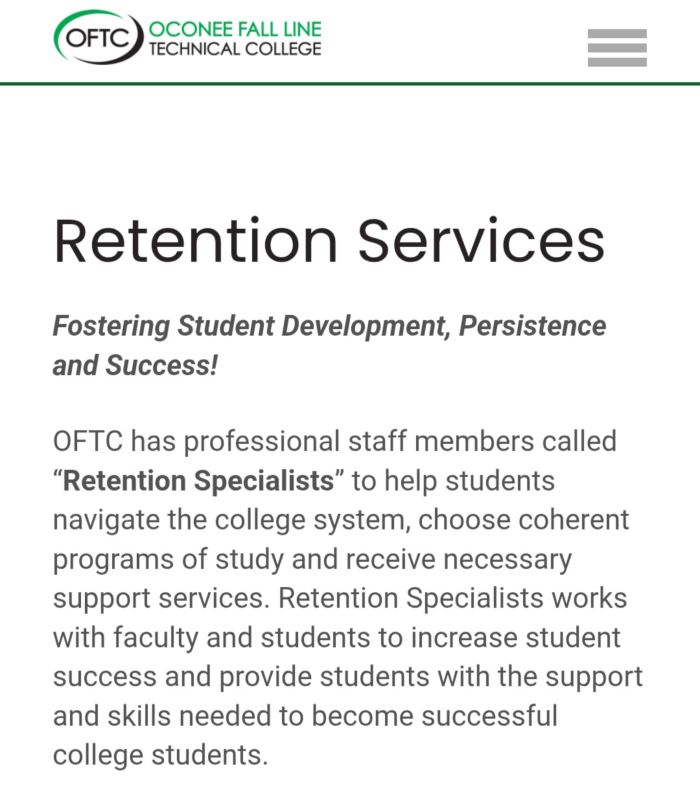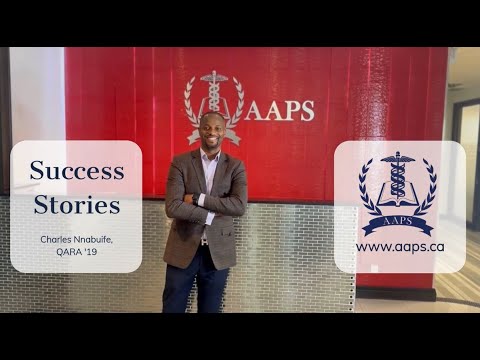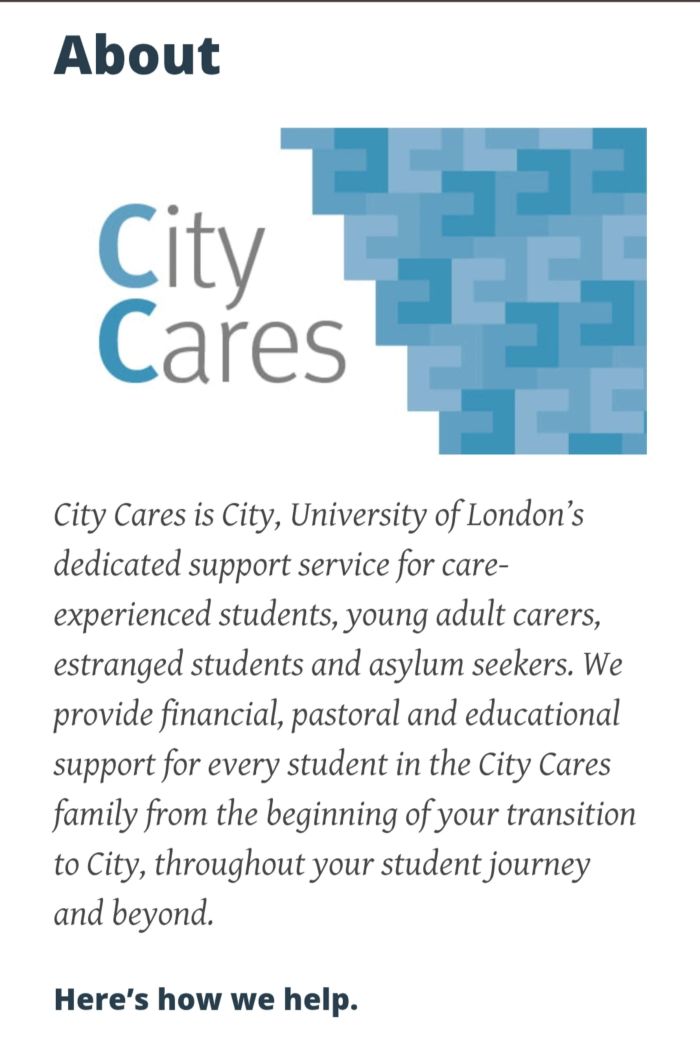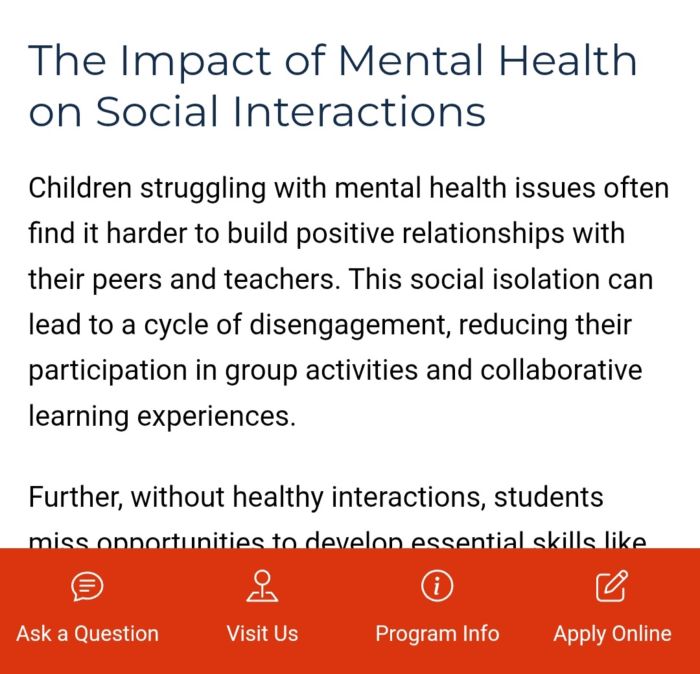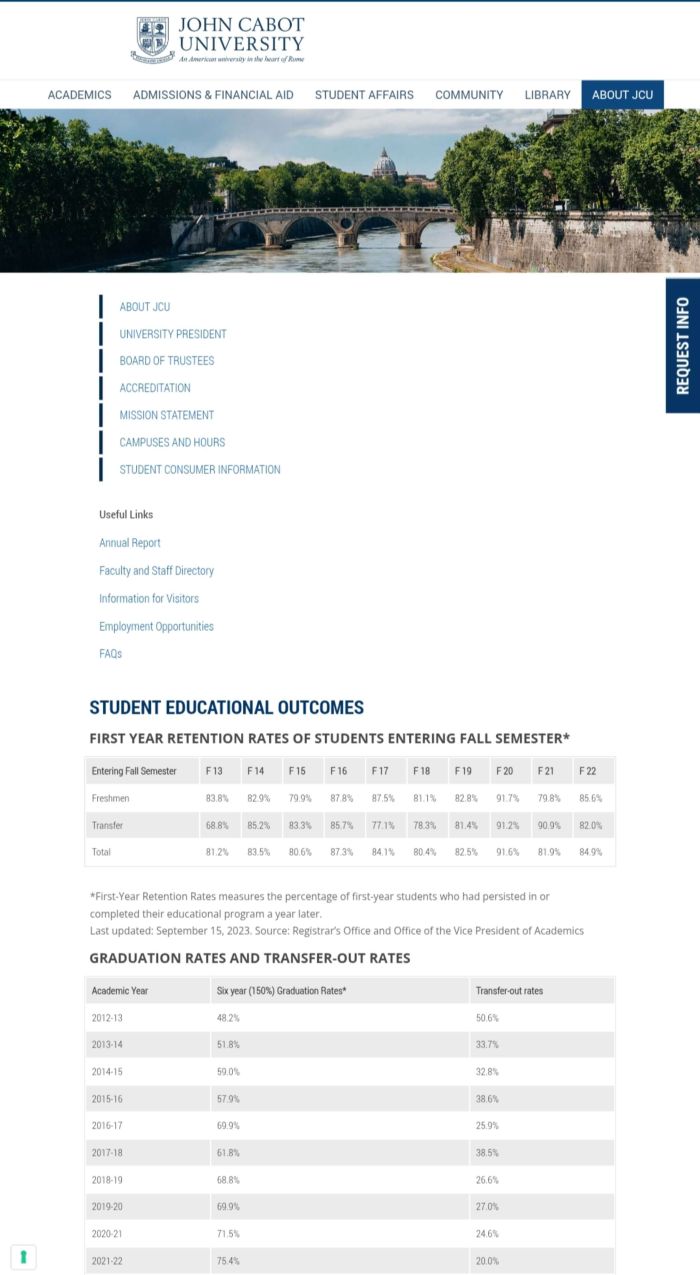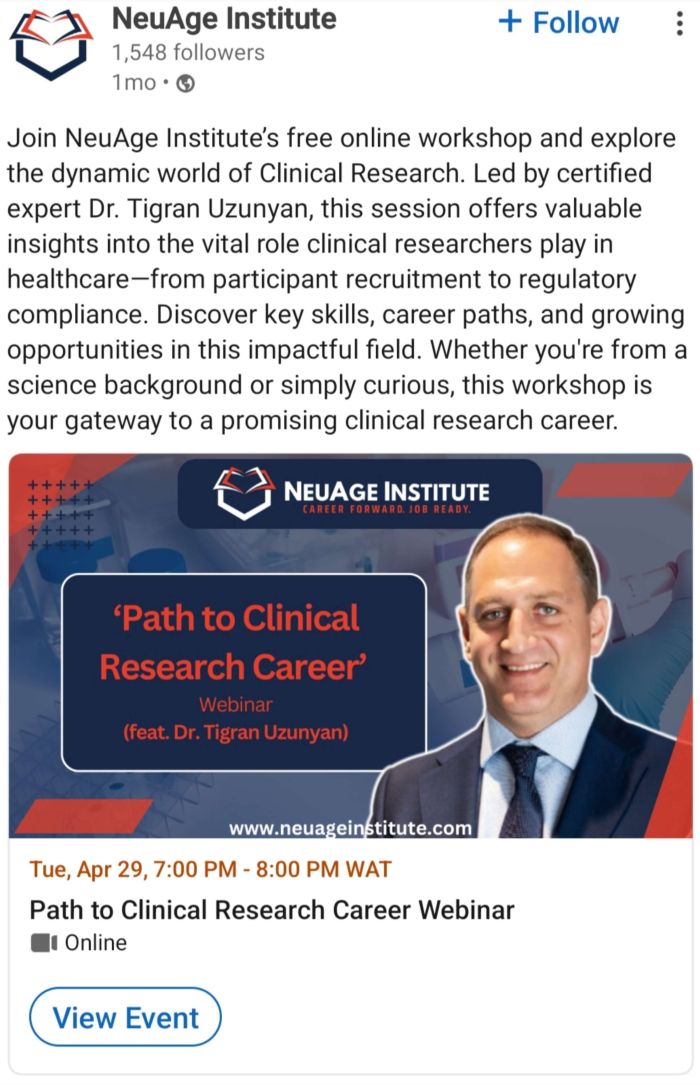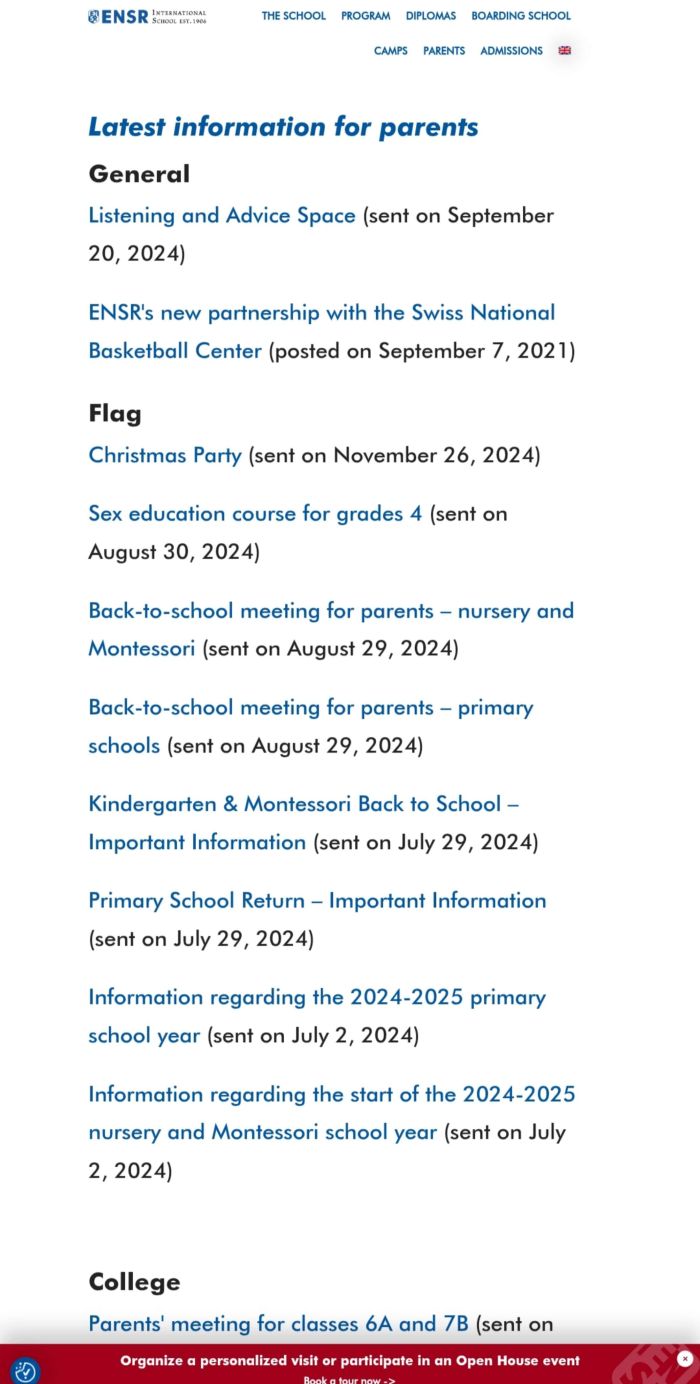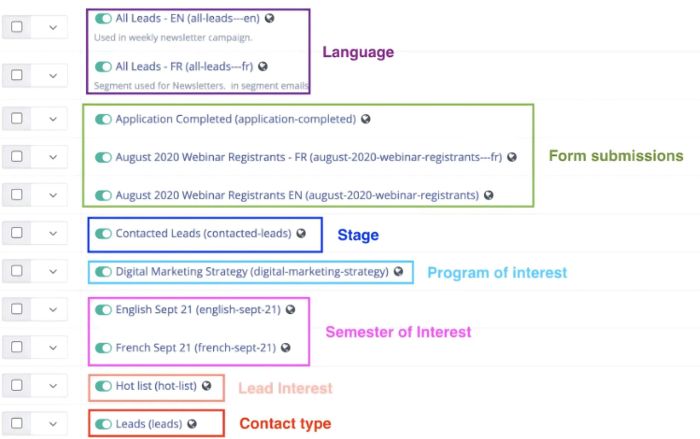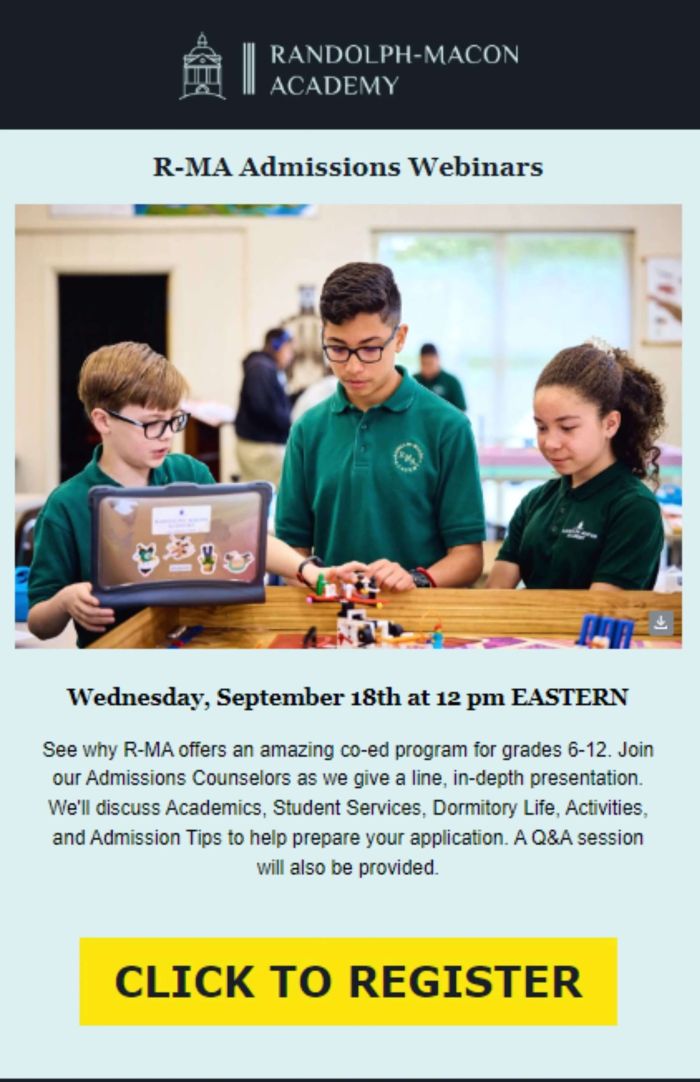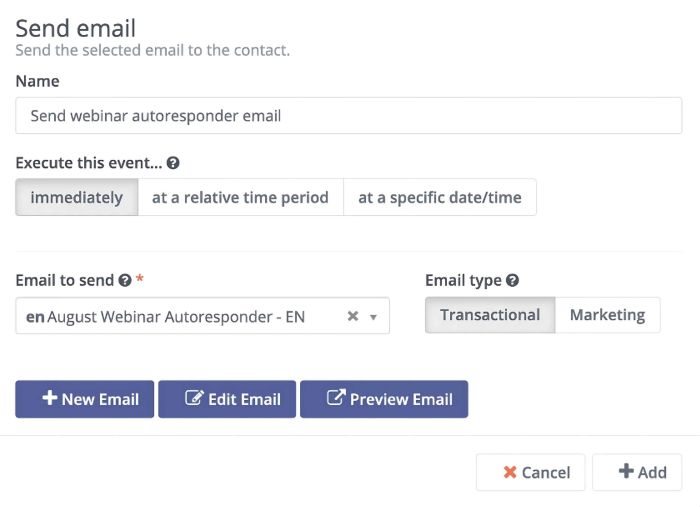Email remains one of the most effective ways for colleges and universities to connect with their audiences. Unlike social platforms that limit reach through algorithms, email marketing for educational institutions provides a direct line to prospects, parents, students, alumni, and partners, people who have already chosen to hear from you. It’s measurable from start to finish, integrates easily with CRMs and student information systems, and can be automated to deliver timely, relevant messages.
The numbers back it up: across industries, email consistently produces one of the strongest returns on investment of any channel. In higher education, the impact is even greater when schools combine clean data with thoughtful segmentation, personalization, and creative storytelling. In practice, email often becomes the foundation of a recruitment strategy, supporting everything from initial outreach to alumni engagement.
This guide brings together proven email marketing best practices for educational institutions. Alongside examples and trusted resources to help your team build campaigns that not only perform but also feel authentic and meaningful to the people you’re trying to reach.
Where Email Fits in the Student Journey
Email plays a role at every stage of the student journey, from the first moment of discovery through to lifelong alumni engagement. What makes it so effective is its ability to deliver the right message to the right person at the right time.
- Awareness: Introduce programs, highlight scholarships, and showcase campus life with engaging stories that spark curiosity.
- Consideration: Share degree guides, student experiences, faculty spotlights, and invitations to virtual or in-person events.
- Decision: Provide deadline reminders, financial aid instructions, advisor booking links, and follow-up checklists that help prospects commit with confidence.
- Onboarding & Retention: Support new students with orientation details, academic advising reminders, wellness resources, and career services updates that strengthen their connection to your institution.
- Alumni & Advancement: Keep graduates engaged with mentorship opportunities, continuing education offers, impact reports, and giving campaigns that showcase the value of staying involved.
Example in practice: The University of Alberta has built a structured email journey for international prospects, connecting them with advisors and surfacing key requirements at each stage of the process. This ensures that students receive timely, relevant information tailored to their current stage in the decision-making process.
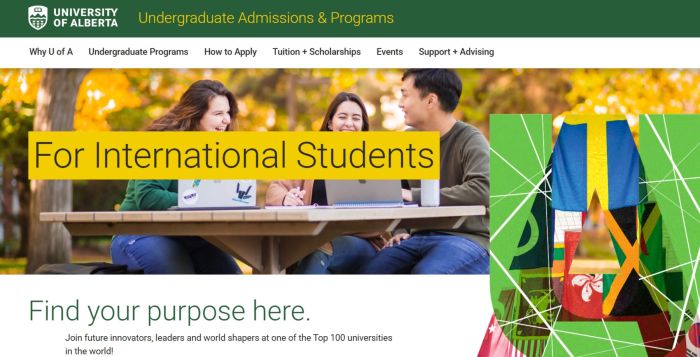

Source: University of Alberta
Best Practices for Higher Education Email Marketing
To make email marketing for educational institutions truly effective, schools need more than just frequent sends; they need strategy, structure, and respect for their audience. The best-performing campaigns are built on trust, relevance, and timing.
That means starting with a clean, permission-based list, segmenting by intent, and delivering value at every step of the journey. Each best practice below focuses on how colleges and universities can move beyond “batch and blast” tactics to create meaningful, high-ROI conversations with students, parents, alumni, and partners.
1. Build a Permission-Based, High-Intent List
The strength of your email marketing starts with the quality of your list. Buying addresses might look like a shortcut, but it usually leads to poor engagement and deliverability issues. Instead, focus on capturing leads through owned, value-driven channels.
Program pages with downloadable guides, open house registrations, scholarship calculators, and career snapshots are all proven ways to attract high-intent prospects. Keep sign-up forms short, just name, email, and one preference field, then use progressive profiling to enrich data over time.
Example: George Brown College attracts prospective students by offering downloadable program guides in exchange for email sign-ups. Because students self-select the guide they want, the college immediately knows their area of interest and can trigger tailored follow-up campaigns. This approach builds a fully permission-based list where every contact has explicitly indicated their intent, making subsequent outreach more relevant and effective.


Source: George Brown College
2. Segment Aggressively for Relevance
Segmentation is the most consistent way to boost engagement and conversions in higher ed email marketing. Instead of sending broad blasts, divide your audiences by lifecycle stage, program interest, geography, or even behaviour, for example, attending a webinar or abandoning a form. This allows every recipient to receive content that feels timely and relevant. Segmentation also prevents fatigue by cutting down on irrelevant sends, which in turn protects your sender reputation and keeps unsubscribe rates low.
How can segmentation improve the effectiveness of email marketing for higher education? Segmentation makes emails more relevant, which increases engagement. For example, international prospects segmented by country can receive updates on visas and housing, while domestic students see local funding options. Segmenting by lifecycle stage, program, and behaviour helps improve click-throughs and leads to better-qualified student interactions.
Example: Humber College’s international portal structures content by region and need, ensuring students see information on study permits, housing options, and support services tailored to their home country. This kind of geo-segmentation can be mirrored in email journeys, for instance, sending region-specific pre-arrival checklists or visa guidance, so that communications land with stronger relevance for each subgroup of students.
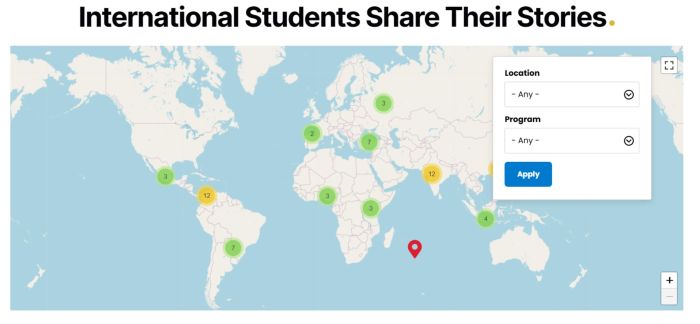

Source: Humber College
3. Personalize Beyond the First Name
True personalization goes deeper than inserting a first name in the subject line. In higher education, it means dynamically adjusting content blocks based on program interest, geography, or behaviour.
For example, prospective Nursing students should see different resources than prospective Business students. International applicants may need tuition estimates in local currency or immigration guidance. Behavioural triggers, like a reminder to finish an application, show prospects you’re paying attention to their journey.
Why is personalization important in higher education email marketing? Personalization helps students see themselves at your institution. Tailoring emails by program, start term, or action, such as reminding them of an unfinished application, makes communication feel relevant and timely. This reduces fatigue and unsubscribes while guiding students toward conversion more effectively than generic messages.
Example: Arizona State University has invested in dynamic email content that highlights degree options, campus resources, and next-step reminders based on each student’s profile data. ASU’s own email marketing guidelines encourage the use of personalized fields and scripting for tailored messaging, ensuring that outreach feels individually relevant and helpful rather than generic.
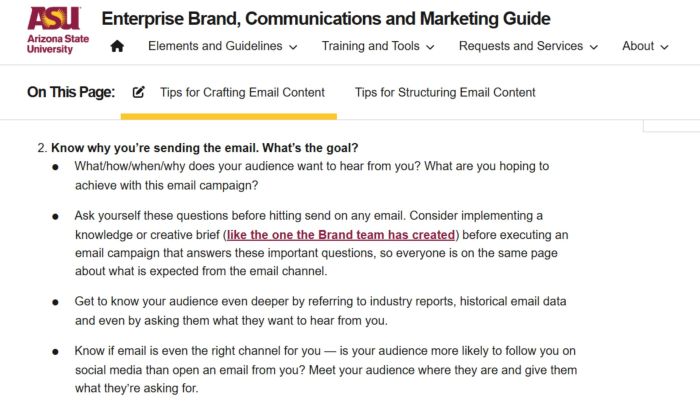

Source: Arizona State University
4. Write Subject Lines and Previews That Earn the Open
Subject lines and preview text are the most decisive factors in whether an email gets opened. In higher education, a few consistent principles stand out:
- Clarity over cleverness: “Fall 2025 Application Deadline: Sept 30” outperforms vague teasers.
- Specificity: call out the program or event directly (“Early Childhood Education: Virtual Info Session Tomorrow”).
- Urgency and utility: use time-sensitive reminders, but avoid spammy tactics (“Last 48 hours for residence priority”).
- Length: keep subject lines to 45–50 characters, and use preview text to complete the thought and front-load value.
- Testing: run A/B tests where possible: subjects, preheaders, and sender names (e.g., “Admissions at Seneca”) are all worth experimenting with. Emoji can work sparingly for student audiences.
Example: The University of Arizona’s marketing team advises keeping subject lines concise (30–50 characters) and imbued with a sense of urgency, while still indicating the email’s content. Their guidelines echo what many have found: clear, direct subject lines (often including deadlines or event details) tend to lift open rates, because recipients immediately grasp the email’s value.


Source: The University of Arizona
In a nutshell, what are the best practices for creating engaging subject lines in higher education email marketing? Keep subject lines clear, specific, and under 50 characters. Highlight benefits like deadlines, outcomes, or events, and use preheaders to expand the message. Test frequently with A/B experiments, and consider humanized sender names (e.g., “Admissions at [School]”) to increase open rates without relying on gimmicks.
5. Design Mobile-First and Accessible
Most students and parents first open emails on their phones, so mobile-first design isn’t optional. Use responsive templates, 16-pixel body text, and tappable CTAs with enough space to avoid errors. Break content into scannable blocks with headings and subheads, and avoid image-only buttons.
Accessibility should be built in: add alt text, maintain contrast ratios, and caption videos. Keeping one clear CTA helps prevent distraction while making the path forward obvious. Load times matter, too. Opt for system fonts, compressed images, and videos hosted externally.
Example: The University of Toronto’s Future Students portal provides a good model for digestible, mobile-friendly content blocks. Information is organized in concise sections and bullet points that mirror best practices for responsive email design. By structuring content for quick scanning on a small screen, U of T ensures that key messages (from program highlights to “Apply Now” links) remain prominent and actionable even on mobile devices.
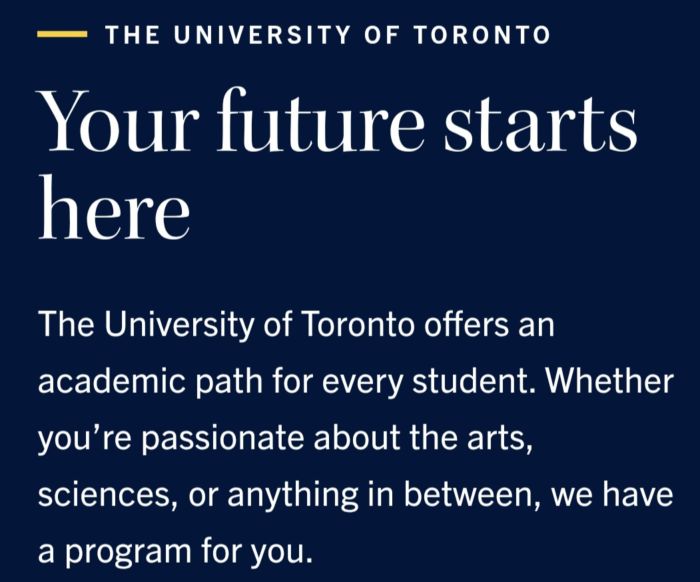

Source: University of Toronto
6. Calibrate Timing and Frequency
How often you email matters as much as what you send. A thoughtful cadence keeps your audience engaged without overwhelming them. Consider these practical benchmarks:
- Prospects: 1–2 emails per week; increase frequency near application deadlines or events, then cool down.
- Applicants/Admitted Students: Send transactional updates and personalized nudges; shield them from generic blasts.
- Enrolled Students: A weekly digest from student affairs or the registrar is usually sufficient, plus urgent communications when needed.
- Alumni: monthly updates with stories, impact reports, and targeted appeals tied to affinity or giving campaigns.
Example: The University of Rochester balances its email frequency by audience: it sends all current students, faculty, and staff a brief daily bulletin for campus-wide announcements, but for undergraduates, it also delivers a focused weekly newsletter highlighting only the most important deadlines and updates for the coming week. This approach keeps students informed and on track (e.g., keeping current on scholarship deadlines or add/drop dates) without inundating them with multiple emails per day, illustrating how strategic timing and pacing can improve engagement.
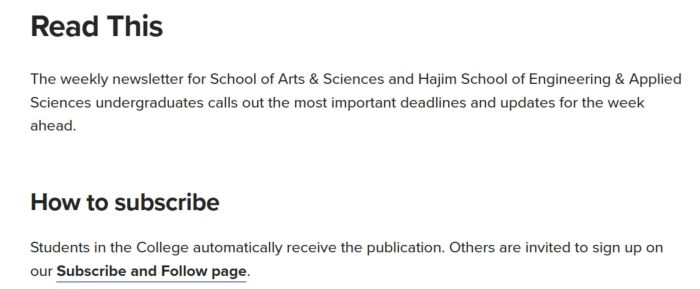

Source: University of Rochester
7. Calls-To-Action That Convert
The best emails guide students toward small, progressive steps that build confidence and commitment. Think of calls-to-action (CTAs) as a series of micro-conversions leading to the big one: enrollment.
- Early stage: “Download the Business Degree Guide.”
- Mid stage: “Register for the Sept 12 Virtual Info Session.”
- Late stage: “Finish Your Application” or “Book a 1:1 with Admissions.”
Example: Concordia University encourages one-on-one engagement by making it easy for prospects to connect with recruitment advisors. In their outreach and on their website, Concordia invites prospective students to “Speak with a recruiter” and provides direct contact links for regional advisors.
By embedding advisor contact/booking links in recruitment emails, they effectively turn email into a two-way channel, and prospects can immediately take the next step of scheduling a conversation, which is often a key conversion on the path to enrollment. This kind of CTA (e.g., “Book a 1:1 Advising Appointment”) helps move students from interest to action at the decision stage.
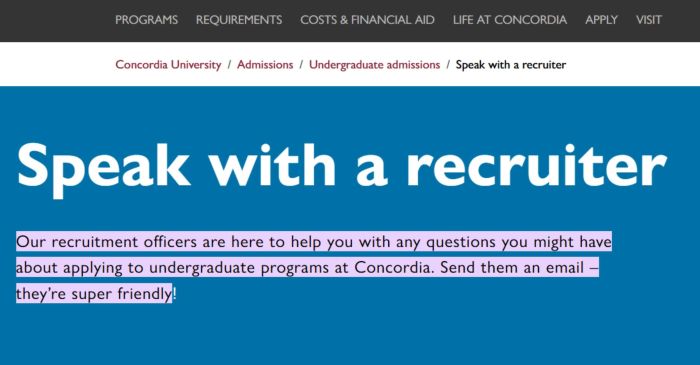

Source: Concordia University
8. Automate Journeys and Triggers
Automation ensures no student falls through the cracks. It also frees staff time by replacing one-off sends with structured flows. At a minimum, schools should build:
- Welcome or nurture series by program cluster (3–5 emails over 10–14 days).
- Event workflows: registration confirmation → reminder emails (24 hours and 2 hours before) → post-event follow-up with recording and next step.
- Application rescue: reminders for incomplete applications, missing documents, or deposits.
- Onboarding journeys: orientation checklist, LMS login, housing information, advising milestones.
Example: The University of Georgia’s admissions office uses automated “incomplete application” emails to prompt action from applicants. About 10–15 days after a student applies, if any required materials are still missing, UGA’s system sends a notification to alert the student. This kind of trigger-based outreach (in UGA’s case, coupled with a status portal for real-time updates) helps increase completion rates by nudging students at the right moment. Ensuring more prospects finish their applications and none are unknowingly left behind due to missing paperwork.


Source: University of Georgia
9. A/B Test Continuously (And Scientifically)
Testing makes email performance predictable. Without it, you’re guessing. To get reliable insights, follow a structured method:
- Hypothesis: define what you’re testing and why (e.g., “Clearer subject line → higher open rate”).
- Minimal variable: test one change at a time: subject, CTA wording, or design. Not everything at once.
- Sample & duration: send to enough recipients for statistical significance, and let the test run its course.
- Centralize learnings: record results in a shared log and bake winners into future templates.
This discipline helps schools turn experimentation into ongoing optimization, rather than one-off guesswork.
Example: Arizona State University’s email marketing team bakes A/B testing into its processes and training. In fact, ASU’s internal Marketing Academy offers specific sessions on email A/B testing best practices. By systematically experimenting, for instance, testing whether an email from “Admissions at ASU” versus a personal advisor name yields a higher open rate, or which subject line phrasing drives more clicks, universities like ASU turn anecdotal hunches into data-backed decisions. The result is a cycle of learning where each campaign performs better than the last, based on real audience insights.
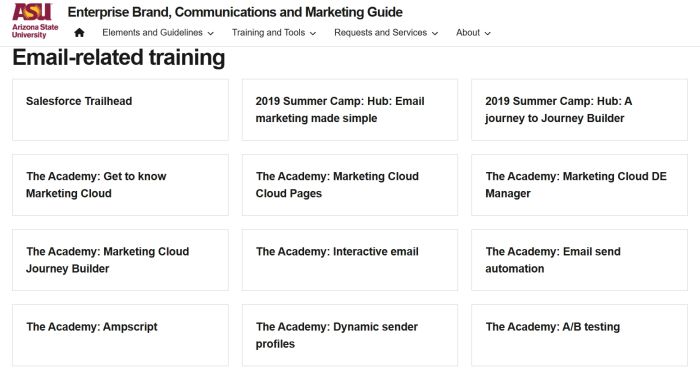

Source: Arizona State University
10. Measure What Matters and Close the Loop
A great email program doesn’t just send, it learns. Schools should define KPIs at each stage of the student journey and connect systems so results tie back to outcomes that matter.
- Top of funnel: track deliverability, open rates (adjusted for privacy changes), and click-through rates (CTR).
- Mid-funnel: measure landing-page engagement, event registrations, and advisor bookings.
- Bottom of funnel: monitor application starts and completions, offers accepted, and deposits paid.
- Lifetime value: go further with retention term-to-term, alumni engagement, and giving participation.
Tools make this possible. Google Analytics 4 allows schools to set and track conversion goals across web and email touchpoints. Marketing automation platforms like HubSpot, Mailchimp, and HEM’s Mautic provide email-level reporting, lifecycle attribution, and integration with CRMs or student information systems.
The real power comes when those metrics are connected—so you can see not just who opened, but who enrolled. That’s how email proves its ROI in higher education.
Example: UMass Amherst provides a powerful case study in data-driven email marketing. After consolidating campus communications onto a single platform, they now rigorously track email performance and outcomes. In 2022, UMass separated its email sends into transactional vs. commercial categories to better gauge effectiveness. The university sent 6.7 million marketing (commercial) emails with a 61% open rate and only a 0.10% unsubscribe rate, about half the industry benchmark.
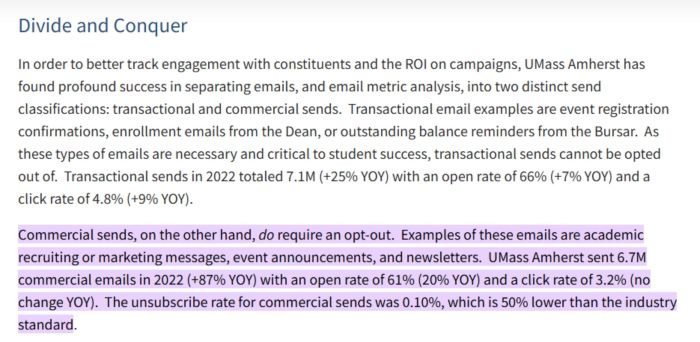

Source: Cloud for Good
These granular metrics (including year-over-year improvements in opens and clicks) are tied back to student engagement and enrollment outcomes. By monitoring and sharing such results, the UMass team can conclusively demonstrate email ROI in higher education, for instance, showing that automated, targeted campaigns directly led to more applicants completing their files and more students registering for classes
Deliverability, Privacy, and Compliance Essentials
Even the best-designed email is wasted if it never reaches the inbox. To protect deliverability and ensure compliance, schools need to focus on three pillars: technical health, consent, and governance.
- Authenticate your domain with SPF, DKIM, and DMARC. Align subdomains for bulk mail so your institution sends with a verifiable identity.
- Maintain list hygiene by removing hard bounces automatically and applying “sunset rules” for long-inactive contacts. This keeps the sender’s reputation strong.
- Comply with Canadian Anti-Spam Law (CASL): capture express opt-in, include your institution’s physical mailing address, and provide a one-click unsubscribe.
- Offer preference centres so subscribers can opt out of specific program streams rather than unsubscribing from all communications.
- Monitor sender reputation and complaint rates across platforms. Coordinate centrally across departments to avoid overlap that leads to over-messaging.
Schools that treat deliverability and compliance as core practices, not afterthoughts, protect both their brand and their audience’s trust, while ensuring every message has a fair chance of being read.
Content Strategy: What to Send (And When)
The most effective email marketing calendars are tied to the academic cycle. By planning content around what matters most to students at each stage, schools can stay relevant, reduce last-minute scrambles, and guide prospects and current learners smoothly from interest to enrollment, and beyond.
- September–October: Focus on discovery. Send “Explore Programs” series, scholarship primers, and fall open house invitations to capture interest early in the cycle.
- November–December: Support applications. Share step-by-step application checklists, portfolio preparation guides, and alumni career stories that reinforce outcomes.
- January–February: Address financial and career considerations. Feature financial aid tutorials, co-op or internship spotlights, and “Ask an Advisor” live chats to build trust and reduce barriers.
- March–April: Drive urgency. Countdown emails for application deadlines, residence selection reminders, and campus life reels or shorts work well here.
- May–June: Transition from admission to enrollment. Focus on onboarding with orientation sign-ups, registrar instructions, and personalized next-step communications.
- July–August: Provide last-mile support. Send guidance on IDs, transit, and housing, plus international arrival instructions to prepare students for day one.
A calendar like this ensures that your emails are not just timely, but also aligned with the emotional and practical needs of your audience throughout the year.
Turning Best Practices Into Results
Email remains one of the most powerful tools available to higher education marketers, but only when strategy and technology work hand in hand. The best practices outlined here are: permission-based lists, segmentation, personalization, accessibility, automation, and compliance. Ensure every message is not just delivered but resonates with the right audience at the right time.
This is where Higher Education Marketing (HEM) makes the difference. With deep sector expertise, we help schools design and execute email strategies that align with recruitment, retention, and advancement goals.
Central to this is our use of Mautic CRM, an open-source higher education email marketing automation platform customized for educational institutions. Mautic allows institutions to manage campaigns, segment audiences, automate journeys, and integrate seamlessly with student information systems, all while keeping data governance and compliance front and center.
By combining best-practice strategy with the flexibility of Mautic CRM, HEM enables institutions to run smarter, more personalized campaigns that drive measurable ROI across the student lifecycle. The result is simple: stronger engagement, higher conversion rates, and a more connected experience for every student, from prospect to alumni. Do you need help crafting an effective marketing strategy for student recruitment for your institution? Contact HEM for more information.
Frequently Asked Questions
Question: How can segmentation improve the effectiveness of email marketing for higher education?
Answer: Segmentation makes emails more relevant, which increases engagement. For example, international prospects segmented by country can receive updates on visas and housing, while domestic students see local funding options. Segmenting by lifecycle stage, program, and behaviour helps improve click-throughs and leads to better-qualified student interactions.
Question: What are the best practices for creating engaging subject lines in higher education email marketing?
Answer: Keep subject lines clear, specific, and under 50 characters. Highlight benefits like deadlines, outcomes, or events, and use preheaders to expand the message. Test frequently with A/B experiments, and consider humanized sender names (e.g., “Admissions at [School]”) to increase open rates without relying on gimmicks.
Question: Why is personalization important in higher education email marketing?
Answer: Personalization helps students see themselves at your institution. Tailoring emails by program, start term, or action, such as reminding them of an unfinished application, makes communication feel relevant and timely. This reduces fatigue and unsubscribes while guiding students toward conversion more effectively than generic messages.


